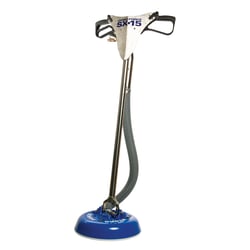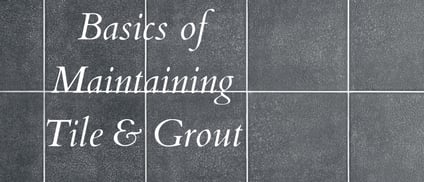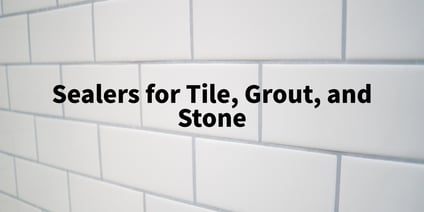
Efflorescence is the natural movement of mineral salts caused by moisture in cementitious grout and appears as a white, chalky substance on the surface of the grout.
Browning is a natural degradation of cellulose found in cotton and jute, which releases lignin that wicks to the surface of the fiber in the form of a brown or yellow stain.
Both processes are natural, but can be made worse by over-wetting. Efflorescence is seen on dark grout, while browning is seen on light-colored cotton fabric and oriental rug fringes. Cleaners approach the cleaning of cotton fabrics with the awareness that browning can happen and take steps to limit it. Cleaners who offer a tile and grout cleaning service need to clean grout with the awareness that efflorescence may have occurred before or after the cleaning and take steps to limit it.
A leading grout manufacturer lists the following on their label: “Efflorescence (a whitish powder or surface crust) can occur in any Portland cement product. Our sanded grout is made with Portland cement and for this reason, we cannot guarantee that efflorescence will not occur. If it does, industry accepted procedures should be followed.” This clearly demonstrates that efflorescence is a natural process. Efflorescence may not occur in the installation, but that does not mean it will not occur later.
Efflorescence is a visual problem on darker grout where a white haze is seen. Efflorescence is not visible on white grout and generally not noticeable on your lighter shades of beige and gray. However, efflorescence is a problem on dark grout. The penetration and presence of water can cause efflorescence. Typically all darker grout that has been mopped will have some visible efflorescence. It is easier to see in the corners and along the wall. Accumulated dirt from mop water will generally hide efflorescence in the middle of the room.
The most important step in dealing with efflorescence is to discuss it with your customer during pre-inspection. Identify the original color of the grout by looking in corners, under rugs or furniture. If it is white, then it will not be a concern. If the grout is colored, then efflorescence may be more visible after cleaning.
Locate an area on the floor where efflorescence is visible. Explain that you will do everything you can to limit efflorescence, but that you cannot guarantee cleaning will not cause or reveal existing efflorescence. Efflorescence can be removed, but it will be an extra charge and needs to be removed after the grout is thoroughly dry.
Water causes efflorescence, which means that we need to limit the dwell time of our presprays on dark grout. After rinsing with a rotary extraction tool, we will want to follow up cleaning passes with a dry pass. Immediately place air movers on tile that has been cleaned to quickly dry the surface of the grout, limiting absorption of water into the grout. If we are going to seal the grout, then we will need to seal with a solvent-based grout sealer for dark grout. This may cause you to come back another day when the grout is dry and when efflorescence has stopped. If there is no efflorescence or at a level acceptable to the customer, then seal with a solvent-based grout sealer. Most water-based impregnating sealers will make efflorescence worse as they are made to penetrate into the grout.
If the level of efflorescence is not acceptable to the customer, then you need to take steps to remove it. A good pre-inspection and explanation of efflorescence as a natural process increases the odds of customer acceptance. Dry abrasion is the first method to try to remove efflorescence. Purchase stiff brushes and run the brush over the surface of the grout. Vacuum the powders removed in the brushing process. This step typically evens out and disguises the efflorescence. This process of removal does not prevent efflorescence from happening again.
An acid surface treatment is the second method for removal. Most industry acid presprays can be used to remove efflorescence. Spray lightly on a small section of grout, brush vigorously and quickly extract with an alkaline rinse. The alkalinity is necessary to neutralize the acid. This process of removal does not prevent efflorescence from happening again.
If efflorescence remains, then it is possible to cover with a colored sealer. Loose powders have to be removed, and the acid has to be neutralized for the colored sealer to bond to the grout. This is a time-consuming process, but should prevent the return of efflorescence for many years. Efflorescence is not something to be feared but can provide additional profit to a tile and grout cleaning job as long as it is pre-qualified.
Featured Products

Hydro-Force, Hard Surface Cleaner, Viper Venom Tile & Grout Cleaner
 Hydro-Force, SX-15 Hard Surface Cleaning Tool
Hydro-Force, SX-15 Hard Surface Cleaning Tool
Enjoyed reading this post? Read the following articles:



